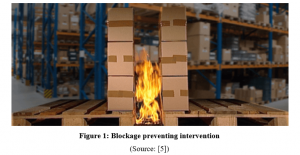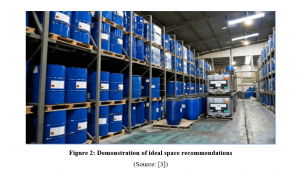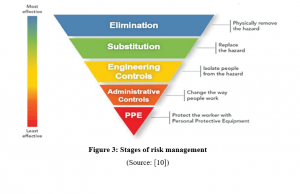Risk Analysis Assignment Sample
Here’s the best sample of Risk Analysis Assignment written by expert.
Abstract
The present report is based on a true case study regarding an explosion of inflammable waste products in Bradbury industrial warehouse services in Campbell field. The report was collected from the news paper report on ABC news. The incident happened due to excessive storage of ware products into store house. The governmental authority cancelled their license due to this incident. Several risk assessment plans, models, theories are available for risk management. Environmental risk management theory with assessment plan are suggest to the Bradbury industrial warehouse company for future developmental aspect and suggested diagrammatic improvement plan for future success.
Introduction
The Bradbury industrial warehouse services in Campbell field are erupted violently due to storage of hazardous and industrial waste beyond the storage limitation. This warehouse provides services regarding storage and disposal solvent waste from paint and related industries. More than 175 fire-fighters were able to manage the blaze and fire crew were using heat detection device to identify dampen. Two young workers were hospitalised, one with serious burns in an induced coma and other one with eye injury. The environmental protection authority suspended the company’s license. EPA found that Bradbury stored enormous amount of explosive amount around 4000,000 litres beyond the limited amount that is 150,000. After inspection, in warehouse it was found that 3000,000 litre of materials already stored into warehouse that are highly inflammable and toxic chemicals. Bradbury services had license suspended compensation paying $15000 fine [1].
Literature Review
Risk assessment plan: There are different risk assessment plan to overcome. Once risks have been identified from the working culture, then following tools are implemented to manage the risk fall. Different types of plans are,
- Reduction plan which use to reduce or mitigate the risk.
- Avoidance plan are used to withdraw or eliminate the risk elements and not involved further in that risk situation [8].
- Sharing plan is being used to transfer the risk situation to another area or to outsource the risk portion along with insurance guarantees.
- Retention plan to accept the cost-budget regarding risk assumption and that are mostly auto-insurance.
Risk assessment process: It is practices the deals with risk assessment process including planning for risk analysis develop new strategies and monitoring and controlling the risk by changing the situation. Risk assessment process includes three phases, risk recognition, risk prioritisation and last risk assessment by implication [5].
Risk Recognition is followed by two steps including context establishment and risk identification. Context establishment defines what risk into area is and risk identification is defined by identifying the risk in this established context that could harm or benefit in association of potential consequences. The outcome of the stage likely affected the whole chain of operation. After identifying the risk, then the next two steps are used for risk analysis and level of risk in order to risk prioritisation. Risk analysis phase is based on quantitative approaches of likelihood. This likelihood depends on frequency and probability of occurrence and that are measured by likert scale in 1-5 level. 1 is for lower level and 5 define the higher risk and severity [4]. After that, two values are multiplied to analyse the level of risk. After evaluate the risk accept the risk assessment management plan to treat the brisk with the help of expert communication and monitor the risk after application of risk management plan.
Therefore, for risk management any industry can follow the four steps including, Risk identification, risk assessment, treatment, monitoring.
Theories related to risk management: The Environmental Resource management theory suggests the seven elements that arte use to manage the risk including portfolio principal, consideration, Underwrite the risk, risk control cycle, assumption about risk and future risk assessment plan [10].
Portfolio principle suggests the expected reward system and loss potential for profit generation. The consideration and underwriting steps are used to base on degree and magnitude of risk. The risk control cycle is implemented to manage the total risk to reduce this capacity. The assumption about risk mainly defines the probability of risk and implements the future risk assessment plan to control the whole risk particular.
According to ERM program, there are four steps are follow risk alignment: Stability, Originality, Accommodation and Consolidation. Stability seeks settle for responsiveness, originality defines the exploration, accommodation is challenge the goal and consolidation is to focused in ERM program, that are seems to provide a valuable self-contemplation.
An agency theory is a financial principle to use for explanation the disputes between agents and principals including shareholder as principals and agents as company executives [7]. Sometimes principles are affected by financial interests due to agents are taking decision regarding company and any loss regarding this decision can affect the principal. Performance based compensation is the only way to mitigate loss of principals and achieve a balance between both decision maker.
Critical analysis and Suggestions
The discussing the risk assessment theory and plan should be implemented on case study scenario for their risk assessment. Bradbury industrial service warehouse must follow the risk assessment structures to eliminate their risk portion.
Bradbury industry service should establish the context of risk in order to amount of storage in-flammable products in their warehouse. Then identify the actual level the storage amount of waste products that are sufficient to store and remains are outsourced. After storing a sufficient amount of waste products that should under the likelihood scale to measure the levels of risk to assess and keep under control.
If it assesses the risk, then treat the risk with ERM seven principal methods. After selecting their risk management plan Bradbury are taken their future plans regarding avoid the store in-flammable element into warehouse and change the plan to bypass the problem. Second step to follow the control and modify the impact of likelihood by creating other store house with optimum level of storage [6]. Then in the third step, Bradbury need to retain and assume the chance of negative impact regarding different storehouse formation with government licensing system, or auto insurance eventually via contingency cost-budget line. The last risk assessment plan that has to be company taken to transfer and share the waste material warehouse from the industrial area and do outsourcing as required day by day. The warehouse should be managed by a third party vendor and this should do by insurance contract. So, the whole risk management acceptance plan should be fruitfully implemented into the company and it makes sure about future problem resolved.
Diagrammatic illustration of the risk levels
Technical defects are primarily responsible for the blast and the spread of fire in the case of Campbell field fire break out. The situations existing in the warehouse increased the risk. The aspects of the engineering guidelines and government regulations for development of chemical toxic substance warehousing that have been avoided in this case is primarily massive stock piling. Other factors include narrow alleys, use of the high bay systems, as well as concentration more than permissible limit of flammable materials which are all conducive to development of fire. It identifies that fire protection measurements are of great significance particularly when storing small load containers containing SLC inside [5]. The figure provided below demonstrates an apparent picture of how the blast occurred because of massive stock piling.

On the contrary, the picture below demonstrates the ideal style of storing small load containers when maintaining a big warehouse or inventory. In this context points out that the most important measure that needs to be undertaken is that operating processes as well as the operating channels should be accompanied with secure exit gateways and there should be legitimate uninterrupted pass ways and delivery capability so that people can be rescued even if some disaster occurs in the interior space of the warehouse [9].

There should also be a hazard control plan in order to provide for the protection of workers at the time of their non-routine operations. The foreseeable emergencies cannot be impended. However, in this context, the awareness plan can e followed.

In the first place there should have been personal protective equipment needed for the safety of the workers. Since, more than adequate workers were associated with the plant and warehouse, there was not adequate PPE. Again, every warehouse handling toxic as well as inflammable materials should make a compulsory regulation so that the employees always wear safety equipment [2]. Administrative control should have been exercised in this case, so that the executive level members of the organization could not make ten discretion of stock piling three times of the permissible load. It is evident that keeping engineering controls was not possible since excessive stocking was done in the warehouse. In the step of substitution, the company should take the responsibility of frequent invigilation for avoidance of excessive stock piling. In the last step, that is elimination, the responsibility is to evacuate the warehouse at first and establish proper evacuation channels and a security management plan.
Conclusion
This incident is an outcome of extensive engineering flaw added to hyper-annulated business expansion plan. In the scope of research, stability, originality, accommodation as well as consolidation have been undertaken in order to substantiate the risk management flaws. The report has also established that a risk level measurement plan have been formulated in order to measure the risk likelihood after storage of a certain quantity of material. In the risk assessment, specific figures have also been provided in order to highlight that elimination and substitution plans are very necessary in order to eliminate such risks in future.
References
- ABC News. “Fire officer says shiver went down his spine when he heard location of Campbellfield fire”. 2019 Available at: https://www.abc.net.au/news/2019-04-06/campbellfield-fire-cleanup-at-bradbury-industrial-services/10978848 [Accessed 1 Oct. 2019].
- Bessette, D.L., Mayer, L.A., Cwik, B., Vezér, M., Keller, K., Lempert, R.J. and Tuana, N. “Building a values‐informed mental model for new orleans climate risk management”. 2017. Risk Analysis, 37(10), 1993-2004.
- Brustbauer, J. “Enterprise risk management in SMEs: Towards a structural model”. 2016. International Small Business Journal, 34(1), 70-85.
- Friday, D., Ryan, S., Sridharan, R. and Collins, D. “Collaborative risk management: a systematic literature review”. 2018. International Journal of Physical Distribution & Logistics Management, 48(3), 231-253.
- Hackl, J., Adey, B., Heitzler, M. and Iosifescu-Enescu, I. “An overarching risk assessment process to evaluate the risks associated with infrastructure networks due to natural hazards” 2015, 105-147.
- Hopkinson, M., 2017. “The project risk maturity model: Measuring and improving risk management capability”. Routledge.
- Li, G., Fan, H., Lee, P.K. and Cheng, T.C.E. Joint supply chain risk management: An agency and collaboration perspective. 2015 “International Journal of Production Economics”, 164, 83-94.
- Mahatma, S., Mojsilovic, A., Ramamurthy, K.N., Varshney, K.R., Wei, D. and Yuen-Reed, G., International Business Machines Corp. “Method for market risk assessment for healthcare applications”. 2016, U.S. Patent Application 14/699,482.
- Paté‐Cornell, M.E., Kuypers, M., Smith, M. and Keller, P. “Cyber risk management for critical infrastructure: a risk analysis model and three case studies”. 2018. Risk Analysis, 38(2), pp.226-241.
- Wong, C.Y., Wong, C.W. and Boon-Itt, S. “Integrating environmental management into supply chains: a systematic literature review and theoretical framework”. 2015International Journal of Physical Distribution & Logistics Management, 45(1/2), pp.43-68.________________________________________________________________________________
Know more about UniqueSubmission’s other writing services:

